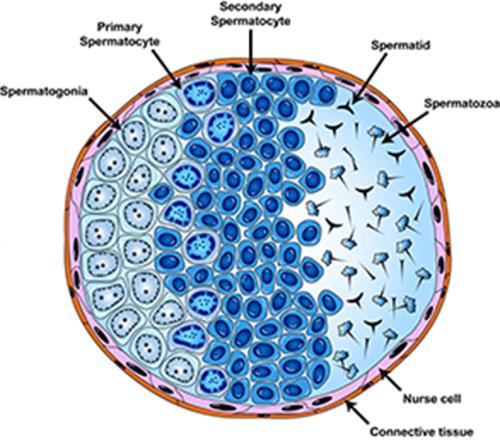当前位置:
X-MOL 学术
›
J. Morphol.
›
论文详情
Our official English website, www.x-mol.net, welcomes your
feedback! (Note: you will need to create a separate account there.)
Morphology of the male reproductive system of freshwater prawn Macrobrachium carcinus (Decapoda, Caridea): Functional and comparative aspects
Journal of Morphology ( IF 1.5 ) Pub Date : 2020-03-04 , DOI: 10.1002/jmor.21115 Thalles F R Ruiz 1 , Mateus R Vidal 2 , Mario V Buzete Gardinal 3 , Karina Ribeiro 4 , Carlos A Vicentini 1, 5 , Irene B Franceschini Vicentini 1, 5
Journal of Morphology ( IF 1.5 ) Pub Date : 2020-03-04 , DOI: 10.1002/jmor.21115 Thalles F R Ruiz 1 , Mateus R Vidal 2 , Mario V Buzete Gardinal 3 , Karina Ribeiro 4 , Carlos A Vicentini 1, 5 , Irene B Franceschini Vicentini 1, 5
Affiliation

|
Testes and vasa deferentia are parts of the male reproductive system of decapod crustaceans. Both organs show morphological differences among decapod species in terms of anatomical and histological patterns reflecting the diversity of this group. Describing these features may assist in systematics, phylogenetics, and studies of reproductive behavior, especially for species of commercial interest, such as Macrobrachium carcinus, a native American species that, unusually for this genus, has no precopulation courting behavior. This study aims to describe the reproductive morphology and spermatogenesis of the male freshwater prawn M. carcinus. The male reproductive system of this species consisted of lobed testes connected to the vasa deferentia. The testis of M. carcinus was divided into several lobules. Each lobule was formed by a cluster of germ cells surrounded by connective tissue and nurse cells. This microscopic anatomy and histology of the testicular histoarchitecture has been described for many species of Decapoda and may represent a derived design of the testes. Unlike that in other decapod species, spermatogenesis proceeds in short transitory phases that produce spermatozoa at high concentrations and frequencies, corroborating the uncommon male reproductive behavior of this species. In the spermatic pathway, the lobules develop and fuse before releasing spermatozoa from the testes; however, this process has not been observed in decapods, yet. The neutral compounds secreted by the vas deferens are important for sperm nutrition as females secrete a substance for spermatophore adhesion during reproduction. This study presents different features and dynamics of the spermatogenic process in the male reproductive system of M. carcinus that have not yet been presented in the literature for decapods.
中文翻译:

淡水虾 Macrobrachium carcinus (Decapoda, Caridea) 雄性生殖系统的形态:功能和比较方面
睾丸和输精管是十足目甲壳动物雄性生殖系统的一部分。两种器官在解剖学和组织学模式方面都显示出十足目物种之间的形态差异,反映了该群体的多样性。描述这些特征可能有助于生殖行为的系统学、系统发育学和研究,特别是对于具有商业价值的物种,例如 Macrobrachium carcinus,一种美洲本土物种,对于该属而言,没有预交求爱行为。本研究旨在描述雄性淡水虾 M. carcinus 的生殖形态和精子发生。该物种的雄性生殖系统由与输精管相连的有裂片的睾丸组成。M. carcinus 的睾丸被分成几个小叶。每个小叶由一组被结缔组织和护士细胞包围的生殖细胞形成。这种睾丸组织结构的微观解剖学和组织学已被描述为许多十足目动物,并且可能代表睾丸的衍生设计。与其他十足目物种不同,精子发生在短暂的过渡阶段进行,以高浓度和频率产生精子,证实了该物种罕见的雄性生殖行为。在精索通路中,小叶在从睾丸释放精子之前发育并融合;然而,这一过程尚未在十足目动物中观察到。输精管分泌的中性化合物对精子营养很重要,因为雌性在繁殖过程中会分泌一种物质来粘附精囊。
更新日期:2020-03-04
中文翻译:

淡水虾 Macrobrachium carcinus (Decapoda, Caridea) 雄性生殖系统的形态:功能和比较方面
睾丸和输精管是十足目甲壳动物雄性生殖系统的一部分。两种器官在解剖学和组织学模式方面都显示出十足目物种之间的形态差异,反映了该群体的多样性。描述这些特征可能有助于生殖行为的系统学、系统发育学和研究,特别是对于具有商业价值的物种,例如 Macrobrachium carcinus,一种美洲本土物种,对于该属而言,没有预交求爱行为。本研究旨在描述雄性淡水虾 M. carcinus 的生殖形态和精子发生。该物种的雄性生殖系统由与输精管相连的有裂片的睾丸组成。M. carcinus 的睾丸被分成几个小叶。每个小叶由一组被结缔组织和护士细胞包围的生殖细胞形成。这种睾丸组织结构的微观解剖学和组织学已被描述为许多十足目动物,并且可能代表睾丸的衍生设计。与其他十足目物种不同,精子发生在短暂的过渡阶段进行,以高浓度和频率产生精子,证实了该物种罕见的雄性生殖行为。在精索通路中,小叶在从睾丸释放精子之前发育并融合;然而,这一过程尚未在十足目动物中观察到。输精管分泌的中性化合物对精子营养很重要,因为雌性在繁殖过程中会分泌一种物质来粘附精囊。











































 京公网安备 11010802027423号
京公网安备 11010802027423号